|
 
IN
THE NEWS | CALENDAR
![Working on his legacy: Sam Swanlund at 71 [photo of Sam Swanlund hand-coloring photo of Carson Mansion]](cover0912-photohed.jpg)
by BOB DORAN
SAM SWANLUND GAZES OUT HIS LIVING
ROOM WINDOW at a panoramic view of Humboldt Bay, in what might
seem to be a moment of repose. It's an illusion. He is still
for a moment, patiently waiting for the photographer to get his
shot, but undoubtedly his mind is racing through the long list
of things he has to do.
At 71, Swanlund is ostensibly
retired -- he sold the Eureka camera shop that bears the family
name 15 years ago -- but he's still a very busy man. On the Wednesday
afternoon when we spoke, he was in the middle of several projects.
He is very active in his church, and there were numerous last-minute
arrangements for a succession of evangelists who were coming
to preach. His duties included publicity and shooting some photos,
and since he had not used his camera for a while, he was getting
it ready.
Swanlund was also preparing
to teach a course on the fundamentals of photography for Humboldt
State's Extended Education. It was less than two weeks away,
but he didn't seem too concerned.
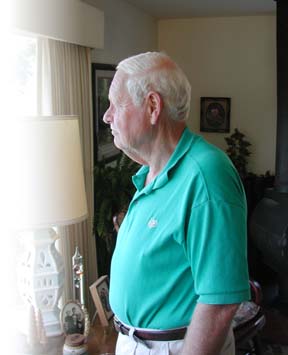 Then
there is the work that he refers to as his "legacy to the
community." He may have left the camera and photo-finishing
business behind, but photographs are still a passion. A studio
next to his hilltop home is crammed to the rafters with works
in progress: oversized prints depicting scenes from early in
the 20th century that he hand colors in meticulous detail. The
black-and-white photos, most of them blown up from 5-by-7 inch
glass plate negatives, are transformed under Swanlund's brush
to become works of art -- just don't describe them that way within
earshot of Sam. Then
there is the work that he refers to as his "legacy to the
community." He may have left the camera and photo-finishing
business behind, but photographs are still a passion. A studio
next to his hilltop home is crammed to the rafters with works
in progress: oversized prints depicting scenes from early in
the 20th century that he hand colors in meticulous detail. The
black-and-white photos, most of them blown up from 5-by-7 inch
glass plate negatives, are transformed under Swanlund's brush
to become works of art -- just don't describe them that way within
earshot of Sam.
You'll find these colorful views
on display at a number of area businesses: Pierson's Building
Supply has a few, some of his first efforts are hung at Angelo's
Pizza, the Humboldt Bay Inn has one in its lobby and Swanlund
is working on a set that will decorate the inn's rooms.
All of the photographs show
views of Humboldt County, the community Swanlund calls home.
SHREWD --
JUST LIKE DAD
"I'm one of those few who
was born in Eureka: February 1931 at the old St. Joseph's Hospital
on G Street," he says with pride as we settle into comfy
chairs in his living room.
Sam's father, Oscar Swanlund,
moved here just after World War I to work as an accountant for
the railroad. "Then for some reason he decided he wanted
to be a photographer, so he bought the Alex Holmes Studio in
downtown Eureka in 1925. It was a portrait and commercial studio.
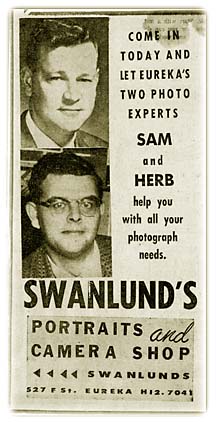 "I
don't know what it was about the business that interested him
or how he got started, but he did very well. I don't think he
was the best photographer around at the time, Ed Seeley was.
But my father was the best businessman; by far. The others
[in the photo business] would come to him all the time wanting
to go into partnership, and he always declined. He was hard-working,
fiscally conservative and very active in the community." "I
don't know what it was about the business that interested him
or how he got started, but he did very well. I don't think he
was the best photographer around at the time, Ed Seeley was.
But my father was the best businessman; by far. The others
[in the photo business] would come to him all the time wanting
to go into partnership, and he always declined. He was hard-working,
fiscally conservative and very active in the community."
It might go without saying that
Oscar instilled his values in his sons. Sam could be describing
himself.
"The business kind of grew;
my brothers both worked there and so did I," he continued.
"My brother, David, set up a laboratory that did a lot of
the photo-finishing for Northern California. My other brother,
Lorrie, went into real estate, but we all stayed here. I guess
that's a bit unusual.
"Even though I went away
for the service and for school, I always intended to come back.
This is my community. It's where I wanted to be. Most of my friends
who went away to the university would say, `I'm not going back
to that hick town.' Now, 50 years later, I'm noticing they're
showing up." He laughs in punctuation. "I always wanted
to be here, always."
Swanlund joined the Army around
the time of the Korean War. He's not sure why, but he was assigned
to the Army Security Agency and trained as a cryptographer or
as the Army put it, "crypt analyst."
While his unit was kept far
from the fighting, his preparation for the assignment included
training in hand-to-hand combat. It's a skill he has never had
to use, although he feels that the knowledge reinforced his self-assurance,
a key component in salesmanship. And Swanlund is a salesman par
excellence.
Asked how he ended up running
the family business, he admits that it was not his original plan.
He had entertained thoughts of becoming a dentist and, after
returning from overseas, made arrangements to attend the University
of California, Berkeley. Then he realized that dentistry might
not be an ideal career for someone who enjoys talking to people
-- and getting a response.
"I didn't really intend
to get into the photography business. When I came out of the
service in 1955 my father said to me, `Why don't you work for
me until it's time to go back to school?' It was just from February
until September, so I said, `Fine.' Thirty-two years later I
sold the business."
In 1958, after working for his
father for a few years, Sam took over the store. "He didn't
give me the business, I bought it," he explains. "And
I gave the going interest rate. That's as it should be."
Sam had enlisted a partner,
Herb Frahman. "I didn't want the loan; I thought it would
be too consuming, so I asked Herb if he would like to be a partner.
He said, `Yes,' and we were partners for 20 years. We worked
hard, but we had a good time. That's what it's all about."
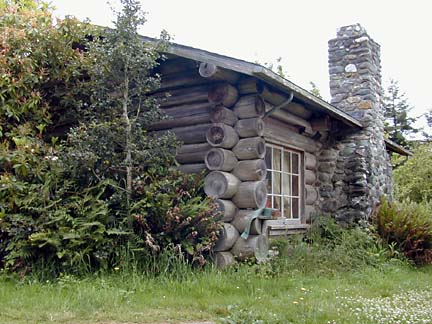 In
1987 Sam sold Swanlund's Camera to Fortuna businessman Patrick
O'Dell, and the camera shop and photo-finishing business became
part of the Humboldt Group. In
1987 Sam sold Swanlund's Camera to Fortuna businessman Patrick
O'Dell, and the camera shop and photo-finishing business became
part of the Humboldt Group.
Swanlund started a new career
in what he refers to as "corporate America." Primarily
he worked on "community relations" for timber giant
Louisiana-Pacific. He did public relations, photography, "tons
of aerial work" and put together a company newsletter.
"They were hardworking
people and I was raised on the work ethic, so it worked out great
for me, hopefully for them too. I got to travel a lot and met
many interesting people.
"I thought of it as a good
way to round out the end of a career. That's what I thought anyway;
it didn't work that way. I still work," he says, concluding
the thought with a short laugh.
STUMBLING
INTO A PASSION
Swanlund spends hours at a time
in his workshop, a rustic log cabin next door to his home. [photo above]
Inside, every available surface is crowded with work in various
stages: large photographs ready to be painted, partially painted
or done and awaiting framing. (He makes the frames himself.)
The source material for the
bulk of his hand-painted photos is a collection of 5-by-7 inch
glass-plate negatives, the work of a photographer, Ray Jerome
Baker, who had a photo studio in Eureka from 1904 until 1910,
then moved with his family to Hawaii. In addition to portrait
work, Baker photographed the towns and villages, the redwoods,
workers in the lumber and tanbark industries, shipbuilders and
shipwrecks.
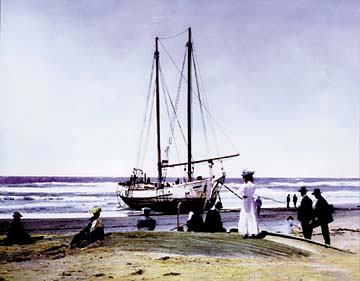
The Corinthian
on the north Humboldt Bar, June 11, 1906, photographer unknown.
"Two men, Carl Christensen
and Lloyd Stine, kept bringing these glass-plate negatives into
the shop and I would make contact sheets for them," Swanlund
recalled, explaining that the men had met Baker in Hawaii and
bought the man's Humboldt work bit by bit.
"I finally asked them what
they were going to do with them. They said, `Oh, I don't know,
do you want to buy them?' I said, `Well, maybe.'" Without
much dickering they agreed on a price. "I paid each of them
$500 and received in return almost 1,400 glass-plates negatives
by R. J. Baker -- and he was good.
"I had something in the
back of my mind. I had two children in private school and it
was killing me, it was very expensive. I thought if I got an
old enlarger and took these plates and made big prints, my mother
could show me how to paint them, and I would sell them.
"I did two big ones and
took them down to the camera shop. Jerry Wilkenloh, who had Eureka
Title, walked in and wanted to buy them. He said, `How much?'
I said, `I dunno.' We settled on $195 apiece. That started this
whole thing."
While Swanlund initially got
involved with colorizing historic photographs as a business deal,
at this point it is more than that: He sees the work as his legacy,
a way to honor the community that gave him so much.
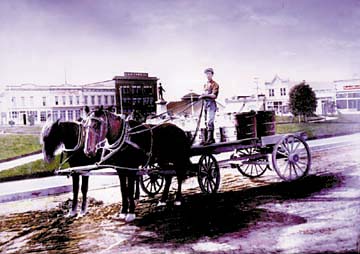
Milk cart on Arcata
Plaza, circa 1915,
photo by A. W. Ericson
Each hand-painted
piece is signed and numbered, and the editions are strictly limited:
He will only paint four copies of any particular photograph.
While there is an art to the work, he does not exactly see himself
as an artist.
"They're real -- not an
artist's conception -- real time and a real place and real people.
There's an art to it, but I don't think it's art."
Whether or not it's art, there
is painstaking research that goes into each piece.
"I did one of a street
car years ago. I ended up tracking down the man who used to run
the streetcar and asked him, `What color was it?' He said, `Tuscan
red.' I knew the color from my interest in trains, so I used
that color.
"I had noticed that it
had no headlight. I wanted to know why, so I called somebody
else. They told me it was because there was vandalism: During
the day kids were throwing rocks, knocking out the headlights.
What they did was put the headlight on at dusk every day before
they took off. How many people know that story? People think
vandalism is only something that happens today. No, it isn't."
In 1985, Swanlund donated the
bulk of the Baker plates, along with other photographs and negatives
from his collection, to Humboldt State University. His gift formed
the core of what is known as the Swanlund-Baker Photograph Collection.
A proviso of his donation was
the right to take home plates for his colorization work. But
he doesn't do that as much as he used to.
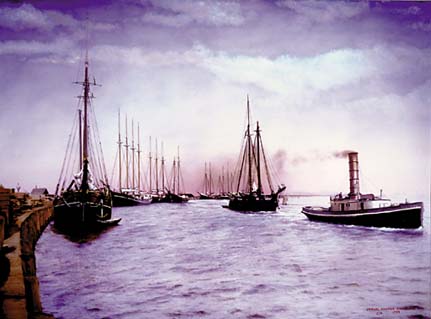
Arcata Wharf in
the late 1800s,
photo by A. W. Ericson
"As long
as I'm alive I can go over there and pick them up, but I pick
up very few -- I'm getting old."
It takes him about 60 hours
of intense concentration to complete a piece. "What surprises
me, at my age I still have an absolutely steady hand, and I use
the same glasses that I bought many, many years ago. I can still
do it, and maybe do it better.
"If I do a locomotive,
it is excruciatingly painful to get it done right, and really
make it look like a locomotive, as if you standing right next
to it. I know I've succeeded when I can reach out and feel the
metal."
The skill he is intent on perfecting
is an ability to use paints to "push and pull," as
he puts it, pulling the subject forward and pushing the background
back, where it belongs. It's something he learned to do when
taking photographs.
"The subject is what photography
is all about -- one subject, please, and [also] a secondary,
that's a must. The secondary could be a pattern, it could be
a color, it could be anything, but you must have a primary and
a secondary, no matter what it is. Then, simplicity. I always
pick simple ones, not complicated, because simplicity is the
key to art."
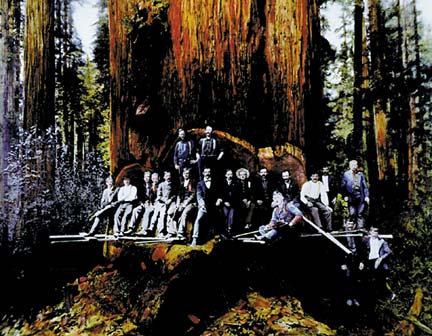
Vance Lumber Co.
crews at Lindsay Creek near Fieldbrook, circa 1897.
REMEMBER
YOUR AUDIENCE
At this point we have wandered
into his other area of interest -- teaching photography, something
he has done for "years and years and years" and something
he still does.
"I tell [my students] I
don't care if you take a garbage can as your main subject --
that's OK -- however, you must do it with craftsmanship. That's
my requirement. It's not what you take, but how well you take
it. And I apply that to the art world today. They've gone off
on a big tangent, and that includes photography.
"My attitude has always
been, `What does the customer want?' Now, if that's crass commercialism,
so be it. But I always go toward, `What do they want?,' not `What
do I want?'
"What you find is the person
whose does work to please the client or the viewer is still with
us. Ansel Adams, and others, were good and their work is still
valid."
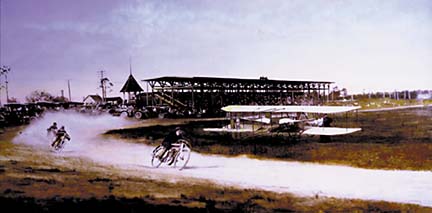
"New Era Park,"
airport and racetrack south of Eureka, July 4, 1914, photographer
unknown.
Mention of the
great photographer turns the conversation to the Adams exhibit
upstairs in what was once his store. "That's Patrick's collection,"
he explains, referring to Patrick O'Dell.
It also stirs up a memory from
his days running Swanlund's.
"One day, long ago, we
were in the store, and a man walked in. I talked to him. He wanted
to buy some book. I said, `Yes, we have it.' We had a pretty
good-sized library at the time. I took him over and showed him.
He came back to the counter, bought it and left. I turned to
the others and said, `Do you know who that was?' They shook their
heads. I said, `It was Ansel Adams.' They didn't even know."
And, as is his habit, he punctuates the tale with his trademark
laugh.
Learn from a PRO
THE FLYER FOR SAM SWANLUND'S
HSU EXTENDED EDUCATION CLASS, "Fundamentals of Photography,"
promises: "Great photography can be taught!" In addition
to learning how to use a camera he offers instruction in "the
techniques of the Great Masters of painting to photography."
This has nothing to do with
hand-painting photos. It is largely based on information gleaned
from a little pamphlet called, "Better Pictures through
Good Composition" written by Ray Koken, a man who showed
up at Swanlund's Camera in the 1950s. Sam bought a few copies
to sell, then when he got around to reading it was so taken with
the way Koken had boiled down the rules of composition that he
ended up taking over distribution, and eventually buying the
publishing rights after the author died.
"It isn't that difficult
-- `make it simple' -- that's what I teach." At this point,
Swanlund shifts into full salesman mode, "I always promise
my class, `If you will listen carefully I will guarantee an increase
of 30 percent, where ever you are, professionals included, I
will raise your quality that much -- if you follow the rules."
Sam Swanlund's Extended Education
class "Fundamentals of Photography" runs from Sept.
17-Oct. 29, 2002 at Humboldt State. For information or to register
call 826-3731 or go to www.humboldt.edu/extended.
IN
THE NEWS | CALENDAR
Comments? E-mail the Journal: ncjour@northcoast.com

© Copyright 2002, North Coast Journal,
Inc.
|